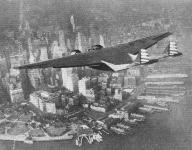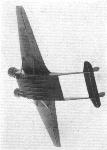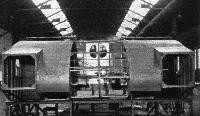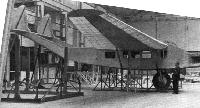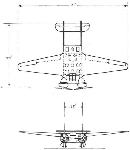
Варианты
- Burnelli - UB-14 - 1934 - США
- Cunliffe-Owen - OA-1 Clyde Clipper - 1939 - Великобритания
Burnelli (самолеты В. Бурнелли)
<...>
Продолжая попытки создания коммерческого транспортного самолета с несущим фюзеляжем, Бурнелли в 1934 году спроектировал и построил UB-14, фюзеляж которого де-факто являлся центропланом крыла. UB-14 выглядел более элегантно, чем его предшественники. Хвостовое оперение с двумя килями крепилось к фюзеляжу на двух балках. Шасси убиралось и выпускалось гидравликой, силовая установка - два звездообразных мотора Pratt & Whitney. Пилот и второй пилот/штурман размещались в смещенной далеко вперед закрытой кабине на верхней поверхности крыла. В кабине длиной 3,35 м и шириной 3,66 м с комфортом можно было разместить до 14 пассажиров. Пассажирский салон был оборудован системой обогрева, вентиляцией, освещением, имелись туалет и багажный отсек. UB-14 был разрушен на земле в 1935 году, когда у него подломилось шасси.
Бурнелли построил затем улучшенный UB-14B, один из таких самолетов был построен в 1938 году британской компанией "Cunliffe Owen Aircraft" - это был усовершенствованный вариант Cunliffe Owen OA-1, построенный в единственном экземпляре и оснащенный двумя звездообразными моторами Bristol Perseus XIVC мощностью по 710 л. с.
В 1935 году Бурнелли спроектировал бомбардировщик А-1, работы по которому не пошли дальше постройки деревянного макета. Однако А-1 послужил базой для создания транспортного планера General Aircraft XCG-16A, построенного в 1943 году и рассчитанного на перевозку до 40 солдат с полной выкладкой. Разработанный Харли Боулсом, XCG-16A имел деревянную конструкцию, размах крыла 28,04 м, максимальную взлетную массу 8618 кг и мог перевозить груз массой до 3992 кг. XCG-16A во всех отношениях превосходил конкурента - самолет Waco XCG-13A, но в серийное производство запущен не был.
<...>
ТАКТИКО-ТЕХНИЧЕСКИЕ ХАРАКТЕРИСТИКИ
Burnelli UB-14B
Тип: транспортный самолет
Силовая установка: два звездообразных мотора Pratt & Whitney Hornet мощностью по 750 л. с. (560 кВт)
Летные характеристики: макс, скорость на уровне моря 338 км/ч; крейсерская скорость на высоте 3050 м-330 км/ч; практический потолок 6705 м; дальность 1996 км
Масса: пустого 4173 кг; максимальная взлетная 7938 кг
Размеры: размах крыла 21,64 м; длина 13,41 м; высота 3,05 м; общая площадь несущей поверхности 63,73 м2
Описание:
- Burnelli (самолеты В. Бурнелли)
- Flight, November 1935
AN UNORTHODOX TRANSPORT
Фотографии
-
Aeroplane Monthly 1980-05 / R.Riding, H.Levy - Burnelli's Lifting Fuselages (3)
Регистрационный номер: X15320 [12], NR15320 [12] При весьма необычном внешнем облике UB-14 вполне мог стать транспортным самолетом, нашедшим практическое применение. Но самолеты Бурнелли были слишком экзотичными для своего времени.
The sole Burnelli UB-14B, X15320, in its original configuration, flying over New York in 1936. -
Flight 1935-10 / Flight
Регистрационный номер: X15320 [12], NR15320 [12] ABOVE THE BATTERY. The new Pratt and Whitney Hornet-engined Burnelli transport tests its split flaps during a test flight over New York.
-
Flight 1935-11 / Flight
Регистрационный номер: X15320 [12], NR15320 [12] UNCONVENTIONAL: This unusual view of the Burnelli UB-14, taken by the Shell company, clearly shows the aerofoil section of the fuselage and the new tapered wings.
-
Aeroplane Monthly 1980-05 / R.Riding, H.Levy - Burnelli's Lifting Fuselages (3)
The prototype UB-14 with its rear fuselage resting on a barrel, illustrating the excellent forward vision from the cockpit.
-
Flight 1935-08 / Flight
AROUND THE WORLD NON-STOP? A "nose-on" view of the Burnelli UB 14 in which Clyde Pangborne hopes to make an attempt to fly around the world, refuelling from other aircraft on the way. A feature of the machine is the aerofoil section fuselage. Note the pilots' position.
-
Aeroplane Monthly 1980-05 / R.Riding, H.Levy - Burnelli's Lifting Fuselages (3)
Vincent Burnelli, left, with test pilot Clyde Pangborn between the two Pratt & Whitney Hornets of the prototype UB-14.
-
Flight 1936-09 / Flight Advertisements
MODEL U.B.14. 14 passengers and 1,000 lbs. of mail
-
Flight 1935-08 / Flight
CLYDE PANGBORN with the new Burnelli fourteen-passenger U.B.14 transport. With two Pratt & Whitney "Hornet" engines, a cruising speed of over 200 m.p.h. is claimed.
-
Flight 1935-11 / Flight
TOWARD THE FLYING WING. The Burnelli UB-14A, which, fitted with two geared and supercharged Pratt and Whitney Hornets, is said to have a performance equal to, if not better than, that of more conventional monoplane transports with similar power. Fourteen passengers are carried and there is ample baggage accommodation in the wings and fuselage. This is the machine in which Clyde Pangbourne once intended to fly non-stop round the world.
-
Aeroplane Monthly 1980-05 / R.Riding, H.Levy - Burnelli's Lifting Fuselages (3)
Регистрационный номер: X15320 [12], NR15320 [12] The UB-14B in original configuration.
-
Aeroplane Monthly 1980-05 / R.Riding, H.Levy - Burnelli's Lifting Fuselages (3)
Регистрационный номер: X15320 [12], NR15320 [12] The UB-14B with modified tail with added fin area.
-
Aeroplane Monthly 1980-05 / R.Riding, H.Levy - Burnelli's Lifting Fuselages (3)
Регистрационный номер: X15320 [12], NR15320 [12] The UB-14B with modified rudders of larger area.
-
Aeroplane Monthly 1984-04 / Personal album
Регистрационный номер: NR15320 [12], X15320 [12] The Burnelli UB-14B NR15320, owned by Sir Hugo Cunliffe-Owen, was flown from the USA to England in October 1937 and is seen here at Eastleigh shortly afterward.
-
Aeroplane Monthly 1980-05 / R.Riding, H.Levy - Burnelli's Lifting Fuselages (3)
Регистрационный номер: NR15320 [12], X15320 [12] The UB-14B painted bright red and registered R15320 for the abandoned round-the-world flight.
-
Aeroplane Monthly 1980-05 / R.Riding, H.Levy - Burnelli's Lifting Fuselages (3)
Регистрационный номер: NR15320 [12], X15320 [12] The UB-14B at Hatfield in December 1937, during the demonstration by Clyde Pangbom.
-
Aeroplane Monthly 1980-05 / R.Riding, H.Levy - Burnelli's Lifting Fuselages (3)
Регистрационный номер: NR15320 [12], X15320 [12] -
Flight 1937-10 / Flight
Регистрационный номер: NR15320 [12], X15320 [12] THE BURNELLI IN ENGLAND: On Monday of this week the American version of the Burnelli was flown over to Croydon from Rotterdam by Mr. S. V. Morton. The owner is Sir Cuncliffe Owen, who originally entered this or a similar machine in the abandoned Atlantic race.
-
Aeroplane Monthly 1980-05 / R.Riding, H.Levy - Burnelli's Lifting Fuselages (3)
Регистрационный номер: NR15320 [12], X15320 [12] UB-14B NR15320 in its penultimate form, with larger engines.
-
Aeroplane Monthly 1980-05 / R.Riding, H.Levy - Burnelli's Lifting Fuselages (3)
The prototype UB-14 after its spectacular crash at Newark. Although the aircraft has been smashed to pieces the interior is virtually intact.
-
Flight 1936-09 / Flight Advertisements
BRITISH BURNELLI ALL-METAL AIRCRAFT with flying - fuselage lifting 25% of the total weight ... as approved by the N.A.C.A.
-
Flight 1937-01 / Flight
UNILATERAL EXPANSION. At the Scotia Works, Willesden, a full-size mock-up of the British Burnelli has been completed. Note the plywood Rolls-Royce Kestrel engine. Some idea of the roominess of cabin and cockpit can be formed from the picture.
-
Aeroplane Monthly 1980-06 / R.Riding - Burnelli's Lifting Fuselages (4)
The full-size wooden mockup at Willesden during the winter of 1936-37.
-
Flight 1937-05 / Flight Advertisements
THE LIFTING FUSELAGE - No. 1. BULKHEAD. The inherent strength and simplicity of construction of the bulkhead is apparent - there are only four such bulkheads in the lifting fuselage as compared with the many bulkheads found in the stream line fuselage.
-
Flight 1937-05 / Flight Advertisements
DURAL EXTRUSIONS FOR BULKHEADS, LONGERONS AND WING SPARS
-
Flight 1937-01 / Flight Advertisements
A Section of the Works and Planning Department, Scotia Works
-
Aeroplane Monthly 1980-06 / R.Riding - Burnelli's Lifting Fuselages (4)
Simplicity of Construction No. 1 THE BRITISH BURNELLI FUSELAGE IS A STRAIGHTFORWARD STRUCTURE AND COMPRISES:- Two flat side panels - large sheets forming upper and lower surfaces - four simple rectangular bulkheads. These four bulkheads, in addition to forming the fuselage structure, are employed as supporting structure for engines, wings, and landing gear. Such a combination into one simple structure of several functions is exclusive to the Burnelli and accounts for the speed of construction and consequent low production costs.
The full-size wooden mockup at Willesden during the winter of 1936-37. Note the painted Rolls-Royce Kestrels. -
Flight 1937-05 / Flight Advertisements
1937 CLYDE CLIPPER (Under Burnelli Patents) 14-20 PASSENGER ALL-METAL AIR LINER
-
Flight 1936-10 / Flight Advertisements
SCOTTISH AIRCRAFT AND ENGINEERING CO. LTD. ANNOUNCE THE ALL-METAL BRITISH BURNELLI BR. MARK II LIFTING FUSELAGE 14-PASSENGER MONOPLANE
-
Flight 1936-09 / Flight Advertisements
The Burnelli Flying-Fuselage design
-
Flight 1935-11 / Flight
These general arrangement drawings of the Burnelli UB-14A show also the passenger seating arrangements.
- Фотографии

